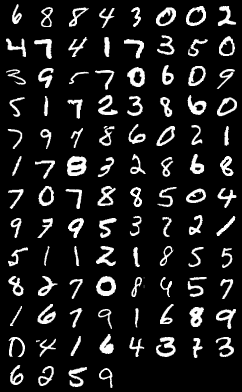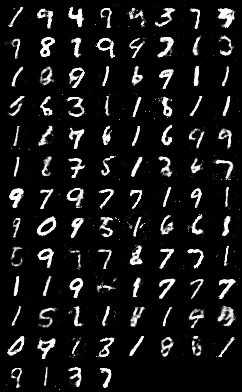版权声明:本文为博主原创文章,未经博主允许不得转载。 https://blog.csdn.net/tlzhatao/article/details/86493065
from __future__ import print_function
import os
import torch
import torchvision
import torch.nn as nn
from torchvision import transforms
from torchvision.utils import save_image
# Device configuration
device = torch.device('cuda' if torch.cuda.is_available() else 'cpu')
# Hyper-parameters
latent_size = 64
hidden_size = 256
image_size = 784
num_epochs = 200
batch_size = 100
sample_dir = 'samples'
# Create a directory if not exists
if not os.path.exists(sample_dir):
os.makedirs(sample_dir)
# Image processing
transform = transforms.Compose([
transforms.ToTensor(),
transforms.Normalize(mean=(0.5, 0.5, 0.5), # 3 for RGB channels
std=(0.5, 0.5, 0.5))])
# MNIST dataset
mnist = torchvision.datasets.MNIST(root='../../data/',
train=True,
transform=transform,
download=True)
# Data loader
data_loader = torch.utils.data.DataLoader(dataset=mnist,
batch_size=batch_size,
shuffle=True)
# Discriminator
D = nn.Sequential(
nn.Linear(image_size, hidden_size),
nn.LeakyReLU(0.2),
nn.Linear(hidden_size, hidden_size),
nn.LeakyReLU(0.2),
nn.Linear(hidden_size, 1),
nn.Sigmoid())
# Generator
G = nn.Sequential(
nn.Linear(latent_size, hidden_size),
nn.ReLU(),
nn.Linear(hidden_size, hidden_size),
nn.ReLU(),
nn.Linear(hidden_size, image_size),
nn.Tanh())
# Device setting
D = D.to(device)
G = G.to(device)
# Binary cross entropy loss and optimizer
criterion = nn.BCELoss()
d_optimizer = torch.optim.Adam(D.parameters(), lr=0.0002)
g_optimizer = torch.optim.Adam(G.parameters(), lr=0.0002)
def denorm(x):
out = (x + 1) / 2
return out.clamp(0, 1)
def reset_grad():
d_optimizer.zero_grad()
g_optimizer.zero_grad()
# Start training
total_step = len(data_loader)
for epoch in range(num_epochs):
for i, (images, _) in enumerate(data_loader):
images = images.reshape(batch_size, -1).to(device)
# Create the labels which are later used as input for the BCE loss
real_labels = torch.ones(batch_size, 1).to(device)
fake_labels = torch.zeros(batch_size, 1).to(device)
# ================================================================== #
# Train the discriminator #
# ================================================================== #
# Compute BCE_Loss using real images where BCE_Loss(x, y): - y * log(D(x)) - (1-y) * log(1 - D(x))
# Second term of the loss is always zero since real_labels == 1
outputs = D(images)
d_loss_real = criterion(outputs, real_labels)
real_score = outputs
# Compute BCELoss using fake images
# First term of the loss is always zero since fake_labels == 0
z = torch.randn(batch_size, latent_size).to(device)
fake_images = G(z)
outputs = D(fake_images)
d_loss_fake = criterion(outputs, fake_labels)
fake_score = outputs
# Backprop and optimize
d_loss = d_loss_real + d_loss_fake
reset_grad()
d_loss.backward()
d_optimizer.step()
# ================================================================== #
# Train the generator #
# ================================================================== #
# Compute loss with fake images
z = torch.randn(batch_size, latent_size).to(device)
fake_images = G(z)
outputs = D(fake_images)
# We train G to maximize log(D(G(z)) instead of minimizing log(1-D(G(z)))
# For the reason, see the last paragraph of section 3. https://arxiv.org/pdf/1406.2661.pdf
g_loss = criterion(outputs, real_labels)
# Backprop and optimize
reset_grad()
g_loss.backward()
g_optimizer.step()
if (i+1) % 200 == 0:
print('Epoch [{}/{}], Step [{}/{}], d_loss: {:.4f}, g_loss: {:.4f}, D(x): {:.2f}, D(G(z)): {:.2f}'
.format(epoch, num_epochs, i+1, total_step, d_loss.item(), g_loss.item(),
real_score.mean().item(), fake_score.mean().item()))
# Save real images
if (epoch+1) == 1:
images = images.reshape(images.size(0), 1, 28, 28)
save_image(denorm(images), os.path.join(sample_dir, 'real_images.png'))
# Save sampled images
fake_images = fake_images.reshape(fake_images.size(0), 1, 28, 28)
save_image(denorm(fake_images), os.path.join(sample_dir, 'fake_images-{}.png'.format(epoch+1)))
# Save the model checkpoints
torch.save(G.state_dict(), 'G.ckpt')
torch.save(D.state_dict(), 'D.ckpt')
G.eval()
with torch.no_grad():
z = torch.randn(1, latent_size).to(device)
images = G(z)
images = images.reshape(images.size(0), 1, 28, 28)
save_image(denorm(images), os.path.join(sample_dir, 'fake_images.png'))


